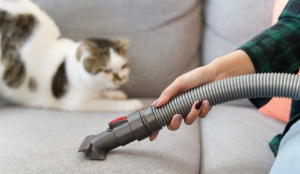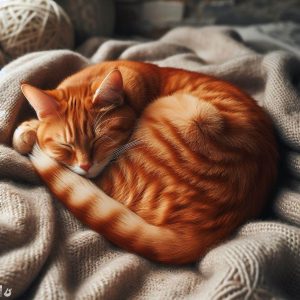Living with cats in an apartment can be so rewarding. But that overpowering litter box smell ruining your indoor air? Not so much. As a devoted cat parent, you signed up for feedings, cuddles and the occasional hairball. You didn’t agree to living in an ammonia-reeked space that constantly smells like stale pee and poop.
The good news is you don’t have to tolerate a foul-smelling home or surrender your furry BFFs to get relief. With some strategic detective work and proven odor-eliminating techniques, you can kick even the worst litter box stench to the curb.
In this guide, you’ll discover:
- How to pinpoint every stinky hot spot your cat could be soiling
- The most effective litters for trapping smell
- Powerful homemade cleaners that destroy odors
- Tricks for removing urine stains and smells from all types of surfaces
- Ways to prevent future accidents by your cat
- When it’s time to call in the professionals
Arm yourself with the right knowledge and game plan, and you can eliminate cat odors from your apartment for good. Read on to start winning the war against litter box smells!
Understanding Why Cat Urine Smells So Bad
Before diving into odor removal solutions, let’s look at why cat pee is so smelly in the first place. Feline urine contains high concentrations of protein byproducts called felinine and auxin.
These aromatic compounds give cat pee its particularly pungent, ammonia-like smell. Even in tiny amounts, the urine proteins produce a strong odor.
When your cat urinates outside the litter box, that concentrated pee gets absorbed into porous materials like carpet, padding, fabrics, drywall and subfloors. Bacteria immediately start decomposing the urine proteins, producing even more noxious odorous byproducts in the process.
The longer the urine sits there uncleaned, the worse the smell gets as bacteria multiply rapidly. In an enclosed space like an apartment, those volatile urine compounds have nowhere to go. Limited airflow allows the stench to remain trapped inside and build up to eye-watering levels.
But don’t lose hope! No matter how bad the odor seems now, you can get your apartment smelling fresh again. By methodically finding every soiled area and properly destroying odors at the source, you can be rid of even the worst litter box smells for good.
Step 1: Sniff Out Every Smelly Zone in Your Apartment
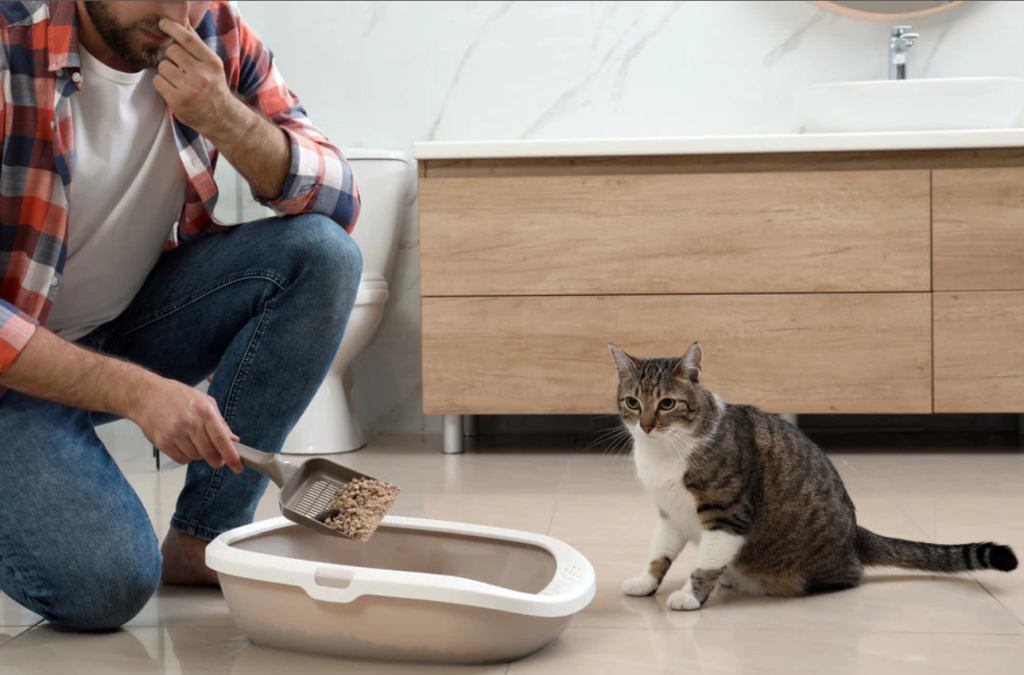
The first step in any deodorizing mission is pinpointing every spot your cats could be urinating or spraying around your home. Cats often repeatedly mark the same areas, so finding all those problem zones is key.
Grab a flashlight and conduct a meticulous nose-led inspection around your entire apartment. Target the prime “pee zones” that tend to attract your cat’s urine:
Check All Soft Surfaces
Carpets and Rugs: Get on your knees and sniff near baseboards, corners and wall edges. Use a UV light at night to reveal hidden stains.
Upholstered Furniture: Carefully inspect the backs, undersides and sides of couches, chairs and cushions. Don’t forget to check crevices and between cushions.
Mattresses and Bedding: Use your nose and a UV flashlight to locate cat pee spots that could be lurking on mattresses, comforters, blankets and sheets.
Towels and Laundry: Check inside hampers and smell clothes before washing. Look for stains or wet spots on fabric items.
Inspect the Floors and Walls
Tile, Vinyl and Hard Floors: Check along edges, grout lines and corners for urine seepage.
Subflooring: Kneel down and sniff near baseboards and wall/floor joints for odors permeating from below.
Drywall and Baseboards: Inspect walls around doorways, vents and any openings cats could spray mark.
Check Lesser Thought Of Areas
Inside Closets: Check shelves, floors, corners and any clothing or fabrics stored inside.
Behind Appliances and Furniture: Move items to sniff behind and underneath large objects.
Inside Air Vents: Peer inside heating and cooling vents to see if any look soaked or dirty.
Insulation Inside Walls: If you smell urine but can’t pinpoint the source, consider that your walls may be getting saturated.
Once you’ve sniffed out all the prime potty zones, make a list of every section that needs attention. Now let’s move onto cleaning!
Step 2: Choose the Best Low-Odor Cat Litter
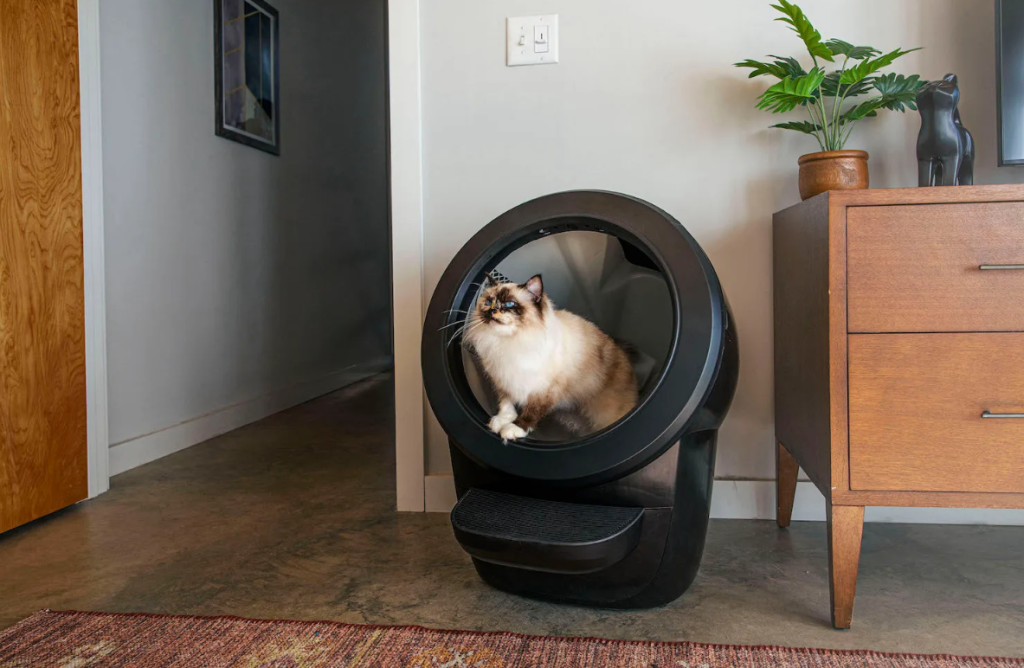
Using the right cat litter is a pivotal part of keeping apartment odors at bay. Here are the top veterinarian-recommended low-smell cat litters:
Clumping Clay Litters
Clay litters containing sodium bentonite clay, like Tidy Cats, Arm & Hammer and Dr. Elsey’s, form tight clumps when wet. This traps urine and odors inside for quick scooping before smells spread.
Crystals and Silica Gel Beads
Crystal litters such as Fresh Step and Precious Cat use lightweight beads or crystals. These absorb liquids quickly while suppressing odors with their porous structure.
Activated Charcoal Litter
Charcoal is very porous and excellent at trapping odorous molecules. Litters like Dr. Elsey’s Ultra absorb smells before they become airborne.
Flushable Paper Pellets
Feline Pine and World’s Best Cat Litter make flushable paper pellets ideal for apartments. The recycled paper naturally beats odors.
Plant-Based Litters
Pine, wheat and corn litters from sWheat Scoop, World’s Best and Feline Fresh are highly absorbent and naturally odor-fighting.
Gradually transition to a new type of litter over 7-14 days. Scoop solids at least once daily. Empty and replace clay litters every 2-3 weeks to maintain freshness. Proper litter box maintenance is crucial!
Step 3: Make a Powerful Homemade Enzymatic Cleaner
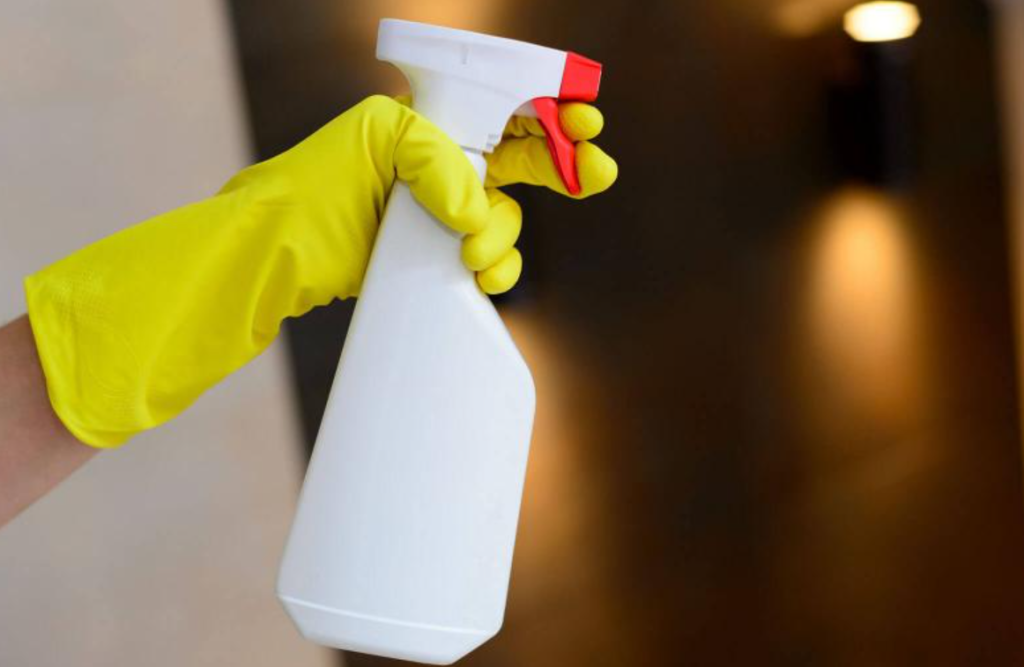
Having the right pet odor cleaner on hand is a must. Here’s an easy homemade solution that works wonders:
You’ll Need:
- 2 cups warm water
- 1⁄4 cup baking soda
- 1⁄4 cup white distilled vinegar
- 1⁄4 cup 3% hydrogen peroxide
- 1 tsp liquid dish soap
- A spray bottle
To Make:
- In a bowl, mix together the water, baking soda, vinegar, hydrogen peroxide and dish soap until fully blended.
- Carefully pour the cleaner into the spray bottle. Shake before each use.
- Lightly spray affected areas, let sit for 5 minutes, then blot thoroughly with clean towels. Allow the area to fully air dry before assessing if more is needed.
The baking soda deodorizes, the vinegar disinfects, and the oxygenating peroxide bubbles away residue. For heavy stains, an enzymatic cleaner like Nature’s Miracle works even better to destroy odor-causing proteins.
Step 4: Remove Cat Urine Smells from Carpets
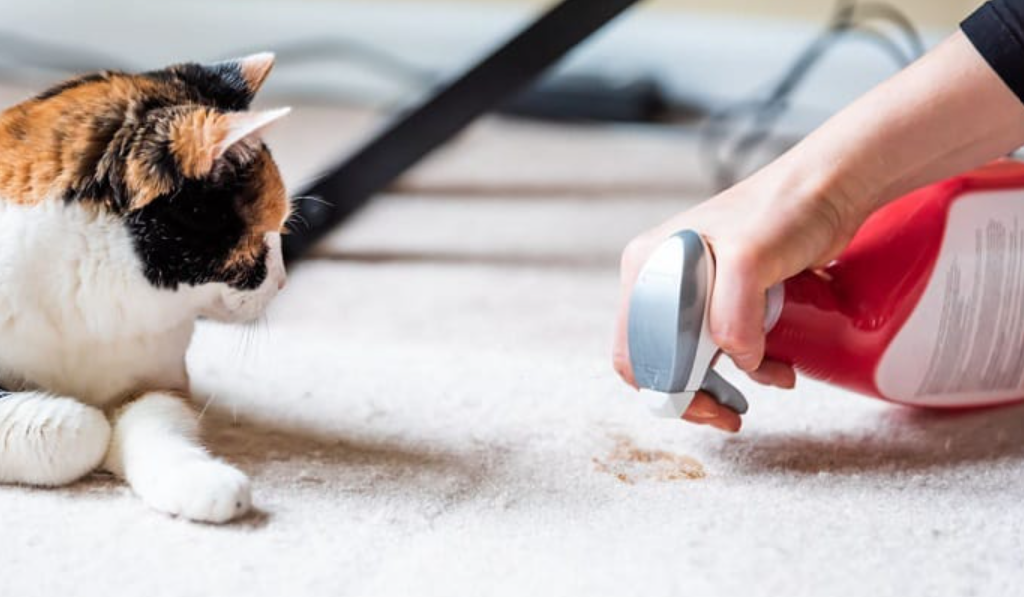
Carpet acts like a giant sponge, soaking up all those malodorous compounds in cat pee with ease. With patience and the right tactics, you can get carpets smelling fresh again:
Act Quickly When Accidents Occur
Immediately blot fresh stains with paper towels when they happen. Avoid excessive rubbing, which drives urine deeper into fibers.
Apply an Enzymatic Carpet Cleaner
Spray or dab on a pet-specific enzymatic cleaner made for carpets, like Nature’s Miracle. Enzymes destroy urine proteins that cause lingering odors.
Coat in Baking Soda
After cleaning, sprinkle a thick layer of baking soda over the area. Allow it to sit for 15-20 minutes before vacuum sucking it up.
Rent a Carpet Cleaning Machine
Deep clean with an extractor machine and pet enzymatic cleaner from a home improvement store. Hot water suction lifts stains from down in carpet fibers.
Replace Heavily Soaked Padding
For old, set-in stains that penetrate down through the carpet backing, replacing the padding is often the only way to fully eliminate odors.
Install New Carpet
In severe cases of cat urine damage, new carpet and padding may be the only solution. Pick an easy-clean, low-pile carpet in durable nylon or olefin.
With repeated cleaning cycles, even longtime urine odors in carpets can be removed. Professional steam cleaning may be needed for stubborn smells.
Step 5: Get Cat Pee Out of Upholstery
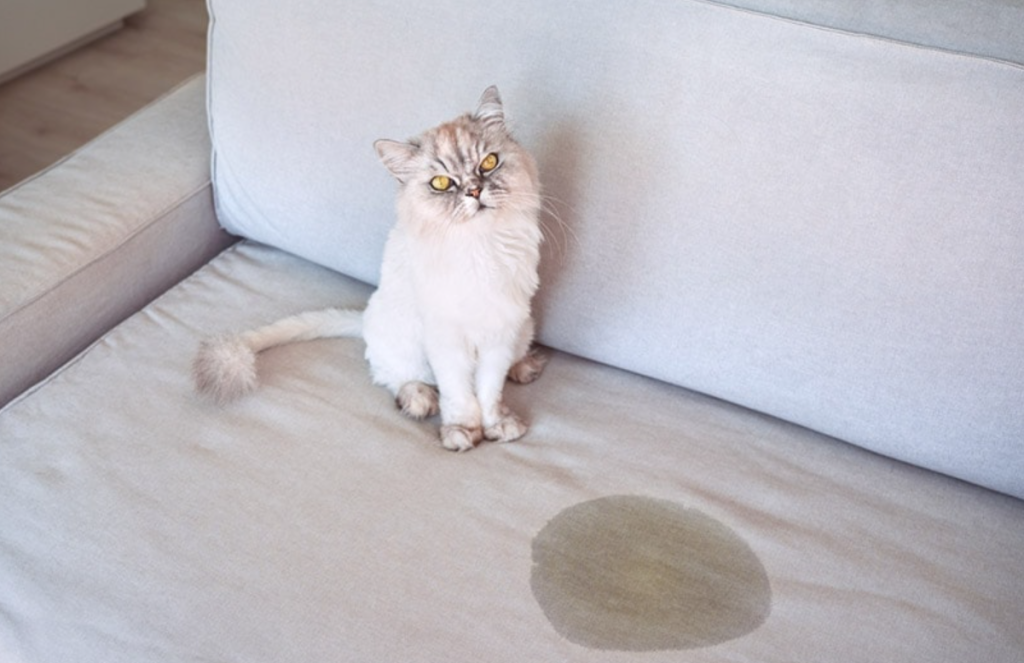
Fabric furniture readily soaks up liquid and odors when cats urinate on it. Use these tips to remove urine smells from cushions:
Blot Wet Urine Immediately
As soon as it happens, soak up fresh pee from fabrics with paper towels. Avoid scrubbing, which drives pee deeper into fibers.
Use a Pet Upholstery Cleaner
Spray or blot on an enzymatic cleaner made for fabrics, like Bissell Pet Odor & Stain Remover. Let it dwell 5-10 minutes before blotting.
Sprinkle and Vacuum Baking Soda
Coat the fabric in baking soda after cleaning. Allow it to sit for 15 minutes before vacuuming away. The baking soda helps absorb lingering odors.
Rent an Upholstery Cleaner
Using an extractor machine with an enzymatic cleaner, deep clean fabrics to lift stains from subsurfaces.
Wash Removable Covers
Machine wash removable cushion covers, slipcovers, blankets and washable pillows with an enzymatic cleaner.
Replace Irreparably Soiled Items
For upholstery and cushions too far gone, professional reupholstering or replacement may be needed to get rid of smells.
With repeated stain treatments and deep cleaning, fabric odors can usually be managed. But severe pet damage may require replacement.
Step 6: Tackle Cat Pee Smells on Floors and Walls
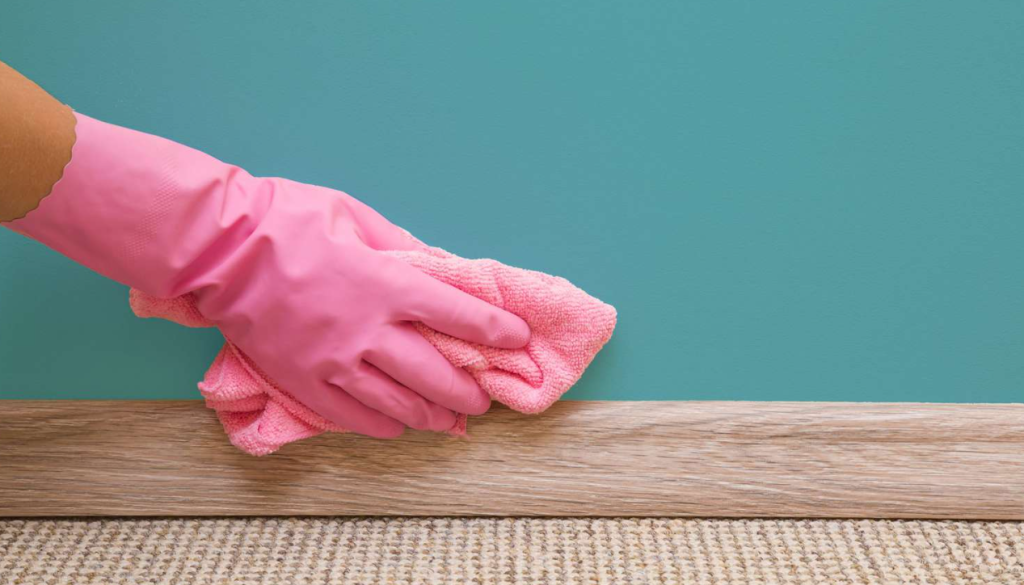
When cat urine seeps into floors, baseboards, subflooring and drywall, special tactics are needed to eliminate odors:
Blot Up Wetness
Immediately soak up fresh accidents on hard surfaces with paper towels. Take quick action before urine seeps into cracks and pores.
Use an Enzymatic Floor Cleaner
Spray on a pet-safe enzymatic cleaner made for hard surfaces. Let it work 5 minutes before scrubbing and rinsing thoroughly.
Try a Vinegar Rinse
For mild stains, wipe down floors with an equal parts white vinegar and water solution. The vinegar neutralizes odors and removes stains.
Scrub with a Baking Soda Paste
Make a paste of baking soda and water. Use a stiff scrub brush and elbow grease to work it into affected porous areas like grout.
Seal Subfloors with Primer
To prevent smells from seeping up from beneath flooring, seal subflooring with an odor-blocking shellac primer like Zinsser BIN.
Replace Damaged Sections
For irreparable urine damage, remove and replace sections of soiled flooring, baseboard or drywall to fully eliminate odors.
Catching stains promptly is key. But with time and effort, even old set-in odors in hard materials can be defeated.
Step 7: Stop Future Cat Peeing Accidents
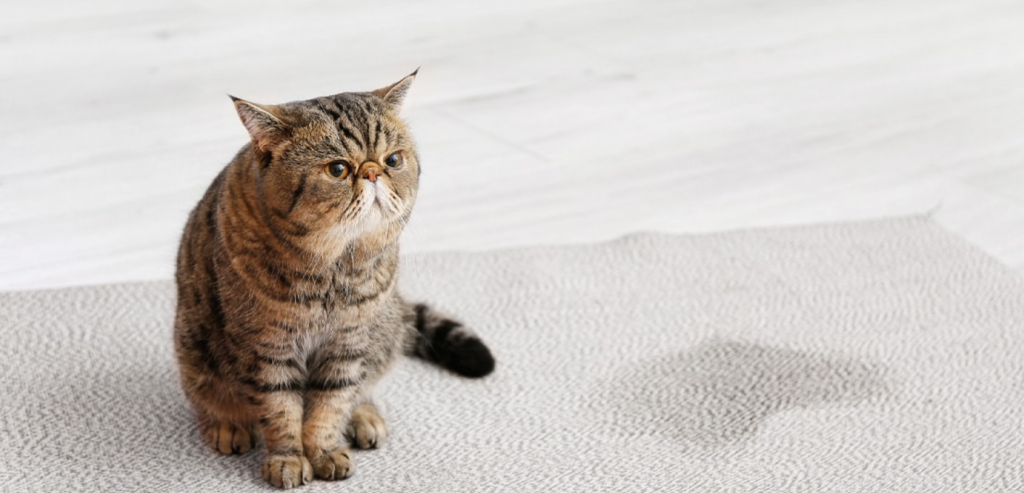
To keep unwanted odors away for good, you need to stop the pee at the source – your cats. Here are tips for preventing recurrent accidents around your home:
- Clean litter boxes twice daily so they stay fresh. Use 1 box per cat, plus an extra.
- Rule out medical causes like UTIs by having your vet examine your cat.
- Try different types of litter until you find one your cat likes using consistently.
- Restrict access to previously soiled areas using closed doors or furniture barriers.
- Place foil, double-sided tape or citrus peels on surfaces to deter your cat from peeing there.
- Use calming pheromone plugins like Feliway to ease stress causing litter box issues.
- Feed cats in once soiled areas so they don’t associate that spot with peeing.
- Use UV flashlights weekly to find fresh stains for quick cleaning before odors set in.
With some effort, you can break the cycle of accidents and stop cat pee before it starts. Patience and consistency are key when modifying behaviors.
Step 8: Maintain a Pee-Free Home
To prevent backsliding into stink, implement these cat odor-fighting practices:
- Sniff around your home weekly for any lingering odors that need attention.
- Re-treat accident prone areas regularly with enzymatic cleaners to discourage reuse.
- Keep removable fabrics clean by washing curtains, blankets and slipcovers frequently.
- Vacuum carpets, rugs, upholstery and mattresses often to remove allergens, hair and odors.
- Scoop litter boxes daily and change out old litter completely every 2-3 weeks.
- Follow your vet’s care recommendations to catch any emerging urinary tract issues promptly.
Staying vigilant is crucial! Don’t get lazy with litter duties or cleaning, or that stench can return quickly.
When to Call In Remediation Experts
For severe cat urine damage beyond your capabilities, don’t hesitate to call the professionals! Seek professional odor removal help if:
- An overpowering ammonia odor persists after deep cleaning all fabrics, floors and walls.
- Urine has soaked into subflooring, drywall or other structural areas.
- You’ve repeatedly cleaned affected areas thoroughly but can’t eliminate the stubborn smell yourself.
Companies like PuroClean and SERVPRO specialize in remediating homes damaged by pet stains and odors. Though pricey, they have the skills, commercial-grade cleaners and equipment to permanently remove even the worst cat pee smells.
Conclusion
While litter box odors can seem unbearable at first, you now have all the knowledge needed to eliminate cat pee smells for good! By finding all soiled spots, proper cleaning methods, and preventing future accidents, your apartment can smell fresh again.
Stay positive and don’t give up hope. With consistent effort using the strategies outlined here, you can successfully rid your home of even the most overpowering ammonia smells. Soon you’ll be relaxing in a clean-smelling space again with your feline BFFs by your side.

